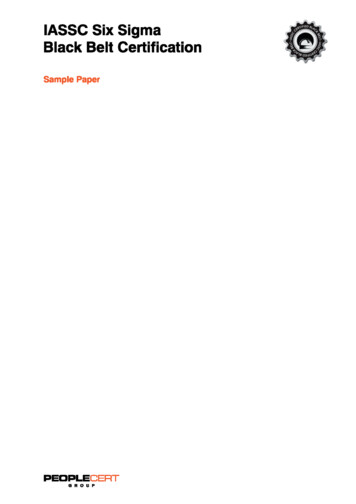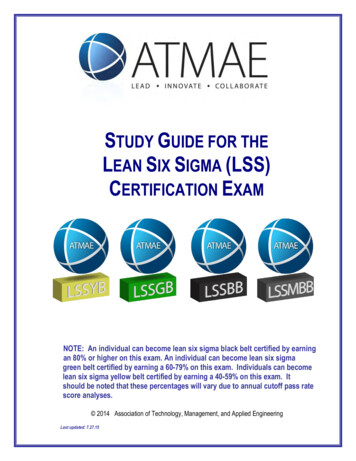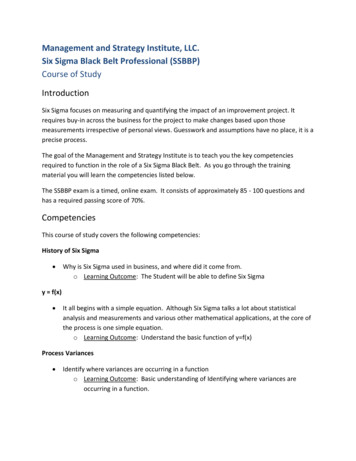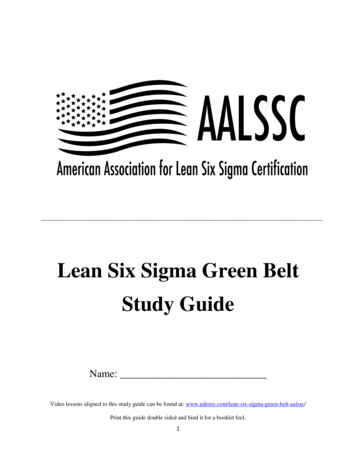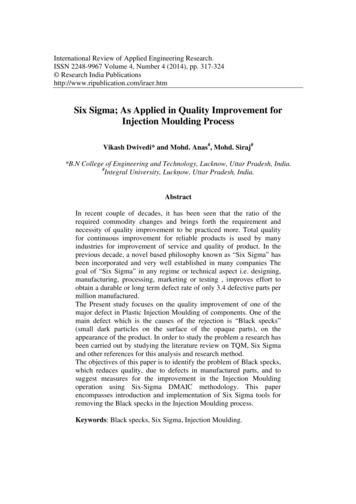
Transcription
International Review of Applied Engineering Research.ISSN 2248-9967 Volume 4, Number 4 (2014), pp. 317-324 Research India Six Sigma; As Applied in Quality Improvement forInjection Moulding ProcessVikash Dwivedi* and Mohd. Anas#, Mohd. Siraj#*B.N College of Engineering and Technology, Lucknow, Uttar Pradesh, India.#Integral University, Lucknow,Uttar Pradesh, India.AbstractIn recent couple of decades, it has been seen that the ratio of therequired commodity changes and brings forth the requirement andnecessity of quality improvement to be practiced more. Total qualityfor continuous improvement for reliable products is used by manyindustries for improvement of service and quality of product. In theprevious decade, a novel based philosophy known as “Six Sigma” hasbeen incorporated and very well established in many companies Thegoal of “Six Sigma” in any regime or technical aspect i.e. designing,manufacturing, processing, marketing or testing , improves effort toobtain a durable or long term defect rate of only 3.4 defective parts permillion manufactured.The Present study focuses on the quality improvement of one of themajor defect in Plastic Injection Moulding of components. One of themain defect which is the causes of the rejection is “Black specks”(small dark particles on the surface of the opaque parts), on theappearance of the product. In order to study the problem a research hasbeen carried out by studying the literature review on TQM, Six Sigmaand other references for this analysis and research method.The objectives of this paper is to identify the problem of Black specks,which reduces quality, due to defects in manufactured parts, and tosuggest measures for the improvement in the Injection Mouldingoperation using Six-Sigma DMAIC methodology. This paperencompasses introduction and implementation of Six Sigma tools forremoving the Black specks in the Injection Moulding process.Keywords: Black specks, Six Sigma, Injection Moulding.
318MMohd. Anas et al1. IntroducttionThiss paper mainlymfocuuses on Six Sigma quality phhilosophy tthat wouldd beimpplemented inn order to identifyithe problem duuring the Innjection Mooulding proccess.Thee “Six Sigmma” Philosopphy is used as it providdes a step-byy-step qualitty improvemmentmetthodology thhat uses stattistical methhods to quanntify variatioon.Being highhly disciplinned processs Six Sigmma helps to focus on ddeveloping anddeliivering veryy close too perfect solutions, productspor services. Walter A. [1]introoduces it inn a differennt way. Six Sigma seekk to reduce variation iin the proceessesthatt lead to thee defects [77, 12]. Six sigma noww implementted and preeferred for highproggress in inddustries [2, 3, 4, 5]. Yaang et. al. [9][ presenteed model off TQM andd SixSimma. Das. P. Studied deelay rejectioon in procuurement of material ussing Six Siggma.Raissinhani, Maahesh. S. [133] has mentioned Six SigmaStools to be widelyy applied noow adays. Yang et al. (2009) Developed integral modelmof a businessbexccellence sysstem[19]]. Xingxingg et al.[18] (2008) andd Chao-Tonn [17] (20008) have diiscussed quualitymannagement teechniques inn the light off six sigma and Six Siggma projectss.The Present study focuuses on the qualityqimprrovement off one of thee major defeect inPlasstic Injection Mouldingg of componnents. One ofo the mainn defect whiich is the caausesof thet rejectionn is “Black specks” (smmall dark particlespon the surfacee of the opaaquepartts), on the appearanceaof the prodduct. In ordeer to study thet problemm a researchh hasbeenn carried ouut by studyiing the literrature revieew on TQMM, Six Sigma and visitiing acommpany.The objectiives of thiss paper is tot identify thet problemm and root cause of BlackBspeccks, that occcurs in the plastic products durinng the Injecttion Mouldiing process andwhiich reduces quality, duue to defectss in manufaactured parts, and to suuggest meassuresfor the improvvement in thhe Injectionn Mouldingg operation using Six-Sigma DMMAICmetthodology. ThisT paper encompassees introducttion and impplementatioon of Six Siigmatoolls for removving the Blaack specks in the Injecttion Mouldinng process. DMAIC standsfor Define,DMeasure, Analyze, Improvve and Conttrol.n moulding process.pFig. 1: black speckk a defect in
Six Sigma; As Applied in Quality Improvement for Injection Moulding Process3192. Injection Moulding ProcessInjection Moulding is a manufacturing technique for making parts from thermoplasticmaterial in production. Molten plastic is injected at high pressure into a mould, whichis the inverse of the product's shape. Injection Moulding machines, also known aspresses, hold the moulds in which the components are shaped. Presses are rated bytonnage, which expresses the amount of clamping force that the machine can generate.The basic injection cycle is as follows: Mould closes - injection carriage forwardinjects plastic - metering - carriage retract - mould open - eject part. The moulds areclosed shut by hydraulics or electric, and the heated plastic is forced by the pressure ofthe injection screw to take the shape of the mould. The water-cooling channels thenassist in cooling the mould and the heated plastic solidifies into the part. Impropercooling can result in distorted moulding or one that is burnt. The cycles get completedwhen the mould opens and the part is ejected with the assistance of ejector pins withinthe mould. The resin, or raw material for injection moulding, is usually in pellet orgranule form, and is melted by heat and shearing forces shortly before being injectedinto the mould. Resin pellets are poured into the feed hopper, a large open bottomedcontainer, which feeds the granules down to the screw. The screw is rotated by amotor, feeding pellets up the screw's grooves. The depth of the screw flights decreasestowards the end of the screw nearest the mould, compressing the heated plastic. As thescrew rotates, the pellets are moved forward in the screw and they undergo extremepressure and friction which generates most of the heat needed to melt the pellets.Heaters on either side of the screw assist in the heating and temperature control duringthe melting process.The channels through which the plastic flows toward the chamber will alsosolidify, forming an attached frame. This frame is composed of the sprue, which is themain channel from the reservoir of molten resin, parallel with the direction of draw,and runners, which are perpendicular to the direction of draw, and are used to conveymolten resin to the gate(s), or point(s) of injection. The sprue and runner system can becut or twisted off and recycled, sometimes being granulated next to the mouldmachine. Some moulds are designed so that the part is automatically stripped throughaction of the mould.3. Six Sigma Methodology: As Applied in Injection MouldingProcessThe application of Six-Sigma methodology is a statistical analysis approach to qualitymanagement and hence the DMAIC method is used for improving the product qualityduring the Injection Moulding is as follows-
320Mohd. Anas et al3.1 Define stage3.1.1 Define the processBefore the process can be investigated, all circumstances have to be defined. Suchcircumstances are often described as SIPOC (Suppliers, Inputs, Process, Outputs andCustomers)3.1.2 Measure phaseIn measure stage the defects per million opportunities is (DPMO) is calculatedmeasure to help monitor progress towards the project goals. Customer expectations aredefined to determine "out of specification" conditions.3.1.3 Analyze stageIn analyze stage the root cause of the Black Specks defect is found out in the partsproduced which is due to five major factors which are machine, environment, operator,method and the material.Machines are one of the factors that must be given Black Specks consideration.The machine contributes a lot of possibilities to Black Specks rejection defect.Examples, without proper parameter setting, it will result to a carbonized screw. Agingmachines also can lead to defects. Maintenance also plays an important part because,without maintenance the performance of machine will be affected and the desiredoutput could not been gained.When an operator does not have enough experience and practice, it is quite obviousthat the operator produces more defects than the others. Defects might occur when jobscarried out without guidance of leader or without any instruction. Besides that, numberof defect will increase when untrained operator or new operators are assigned to do thejob. The work method is another major cause of the problem. It was found that theoperator did not know the correct method set the machine and the parameters but onlyfollowed the instructions without knowing the correct method. As a result the operatorcan lead to black specks defect or other rejection.Besides that, a material is an important medium in injection moulding process thatcontributes to some major defects. Examples, when material are contaminated withother foreign particles it will affect the properties of the part and at the same time itlead to major defects.Some other factors areDAMAGED BARREL OR SCREW; A cracked injection cylinder or pitted screw is acause of material hang-up and degradation. Eventually this degraded material breaksloose and enters the melt stream, appearing as specksCONTAMINATION FROM LUBRICANTS: Excessive use of mould release willclog vents. The trapped air cannot be evacuated and burns. Also, grease that is used forlubricating cams, slides, ejector pins, etc., can seep into the mould cavity andcontaminate the moulded part.
Six Sigma; As Applied in Quality Improvement for Injection Moulding Process3213.4 Improve stageAfter collecting and analysing the data suggestion is recommended to reduce thedefect. And the suggestions are to clean Barrel and use of cleaning agent for cleaningScrew and Barrel Screw.MINIMIZE DOWNTIME AND REDUCE SCRAP; Special Material is cleaned onthe first pass, minimizing machine downtime to maximize the productivity. This alsoreduces scrap so do not waste resin.ECONOMICAL;- Only a small amount of material is needed to purge quickly andeffectively. It has unlimited life.SAFE TO USE;-Special material is non-chemical / no-hazardous and no abrasive.It does not cause wear on machines. It is safe for machines and operators and safe fordisposal.Based on the suggestion given, the rejection rate can be reduced and at the sametime the sigma level can be improved.3.1.5 Control stageControl stage is another important stage before completing DMAIC methodologies.This stage will describe the step taken to control. One of the common types of qualitytool used is the control chart.Sigma level is computed as Z 0.8406 '{29.37-2.2211n(DPMO)} Where, DPMO DPU/CTQ*106,DPU defect per unit Rejection/Total pieces,CTQ critical to quality.through SIPCO (supplier, input, process, customer,output)4. Result and DiscussionDMAIC method of Six Sigma was implemented considering four machines as shownin Table 1.It shows that the highest rejection rate was identified in the month February (2012).Thus lowest sigma level i.e. 4.2356 was recorded for the month of February whereasthe highest being 4.331 for May. The study is focussed for February. Further, MachineE02 has higher rejections due to black specks. Thus this machine will e required foranalysing the root cause. A Brainstorming was carried on to discuss the problem. Theroot cause is given fig. 5.7Table 1: Total output and sigma level.MonthFeb.Output149760MachinesTotal DPMO 56
322Mohd. Anas et ig. 2: Root cause analysis for lack specks.5. ConclusionFollowing suggestions are given a. clean Barrel and use cleaning agent for cleaningScrew and Barrel c. sand paper can also be used Most of the dirt was identified fromthe material which was carbonized because of overheated in the barrel. The overheatedmaterial will stick on the screw and will release slowly each time injection and causedfor the black specks on the surface.References[1][2]Walter A. Shewhart-"Father of Statistical Control," Quality progress, January1986, pp. 50-51Harry, M.J. and Schroeder, R. (2000) "Six sigma: The Break through Management strategy revolutionizing the World's Top corporations."Doubleday, New York.
Six Sigma; As Applied in Quality Improvement for Injection Moulding 5][16][17]323Sanders, Doug; & Hild, Cheryl “A discussion of strategies for Six Sigmaimplementation” Quality Engineering. Vol.12, No.3, 303-309, 2000.Pande, Peter S.; Neuman, Robert P; & Cavanagh, Roland R. The six sigmasay: sow GE, Motorola, and other top companies are honing theirperformance. McGraw-Hill -New York - 2000.Snee, R. D. “Dealing with the achilles hell of six sigma initiatives – Projectselection is key to success” Quality Progress. March, 66-72, 2001.Coronado, R. B., & Antony, J., 2002, “Critical success factors for thesuccessful implementation of six sigma projects in organizations,” The TQMMagazine, 14(2),92-99.Park, S. H., 2002, “Six sigma for productivity improvement: Korean businesscorporations,” Productivity Journal, 43(2), 173-183.Rajagopalan, R., Francis, M., & Suarez, W., 2004, “Developing novelcatalysts with six sigma,” Research Technology Management, 48 (6), 377391.Yang, Ching-Chow, (2004), “An integrated model of TQM and GE SixSigma”, International Journal of Six Sigma and Competitive Advantage, Vol.1 No. 1, pp. 97-111.Das, P., 2005, "Reduction in delay in procurement of materials using sixsigma philosophy," Total Quality Management and Business Excellence,16(5), 645656.John Gershenson, Pavnaskar, S.J., "Application of Value Stream Mapping toLean Engineering," International Journal of Advanced ManufacturingSystems, Volume 8, No. 1, 2005-01-00.John Gershenson, Ye, X., Khadke, K., Lai, X., Guo, F. , "An Introduction toProduct Family Evaluation Graphs," Proceedings of the 2005 ASME DesignEngineering Technical Conferences -- 17th International Conference onDesign Theory and Methodology, Long Beach, California, 2005-09-00.Raisinghani, Mahesh S. “Six Sigma: concepts, tools, and applications”Industrial Management & Data Systems.Vol.105,No.4,491-505,2005.Kim, Dong Suk (2006). A study on the service quality evaluation ofUniversity Library applying the LibQUAL . Ewha Woman's UniversityDepartment of Library and Information Science a master's thesis(writteninKorean).Kwak, Y. H., & Anbari, F. T., 2006, “Benefits, obstacles and future of sixsigma approach,” Technovation, 26, 708-715.Lee, Seung Young, Yoon Jae Yong Kim, TaeHyum, Sohn, Soyoung, "Astrategic Analysis of Korean Engineering Education based on two satisfactionscores", Journal of engineering Education, (April 2007).Chao-Ton, Su, Chia-Jen, & Chou, 2008, “A systematic methodology for thecreation of Six Sigma projects: A case study of semiconductor foundry,”34(4), 2693-2703.
324Mohd. Anas et al[18] Xingxing, Zu, Lawrence, D., Fredendall, & Thomas, J., Douglas, 2008, “Theevolving theory of quality management: The role of Six Sigma,” Journal ofOperations Management, 26(5), 630 – 650.[19] Yang, Ching-Chow, (2009). “Development of an integrated model of abusiness excellence system”, Total Quality Management & BusinessExcellence, 20 (9-10), 931-944.[20] Chun-Chin, Wei, Gwo-Ji, Sheen, Cheng-Ting, Tai, & Kuo-Liang Lee, 2010,"Using Six Sigma to improve replenishment process in a direct sellingcompany," Supply Chain Management: An International Journal, 15(1), – 9.
ix Sigma problem du as it provid ods to quan Six Sigm olutions, p Sigma seek sigma now ng et. al. [n in procu ioned Six S integral m Chao-Ton six sigma uality impr ents. One o all dark p uct. In orde ature revie o identify t ducts durin in manufa Moulding s introduct n the Inject e and Cont



